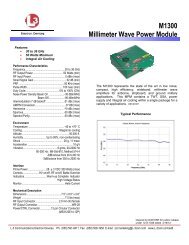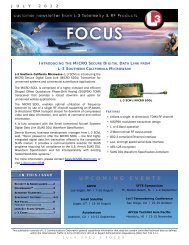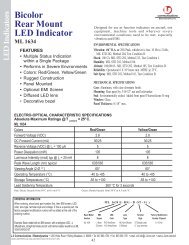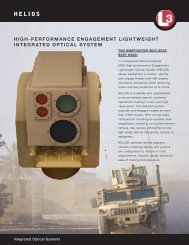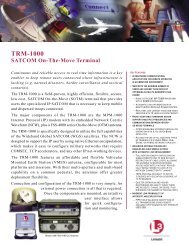Copyright © 2009 IEEE. Reprinted from Microwave Magazine - L-3 ...
Copyright © 2009 IEEE. Reprinted from Microwave Magazine - L-3 ...
Copyright © 2009 IEEE. Reprinted from Microwave Magazine - L-3 ...
Create successful ePaper yourself
Turn your PDF publications into a flip-book with our unique Google optimized e-Paper software.
enabling the exploitation of this region of the electromagneticapplication space.MPM functionality will also continue to increase.Most of this increase will come through higher levelsof integration, such as that exhibited by the MPMtransmitter (MPM-T). The MPM-T unit is a MPMassembly providing integral cooling, reverse andforward power sampling, linearization, harmonicand electromagnetic interference (EMI) filtering,serial interface control, and optional input signalup-conversion. The MPM-T, therefore, provides thesystem user a drop-in transmitter subassembly whilestill retaining all the desirable performance attributesof the MPM. A comparison of 75–100 W solidstate and MPM forced air-cooled Ka-band amplifiersshows the MPM-T to be a factor of two times smaller,lighter, and more efficient than an equivalent SSPA.Lastly, while it may come as a surprise to some, thereliability of the MPM-T assembly is expected to beon par with, if not better than, that of an SSPA. Theoutput power of some sample MPMs and MMPMs isshown in Figure 7.Current Status of Klystron AmplifiersKlystrons operate <strong>from</strong> UHF to millimeter-wave frequencies.They possess high gain, dynamic range,power, efficiency, and low noise, albeit with relativelynarrower bandwidths compared to TWTAs.Among the many applications for klystrons is theirlong use as the workhorse for high-power transmittersin terrestrial broadcast and satellite communications.Continued technical improvementshave further reaffirmed their dominance. In [31], byincorporating MSDC, the saturation efficiency for a2.4 kW klystron designed for direct broadcast satellite(DBS) band was raised <strong>from</strong> 24% to 40%. This im -provement can result in savings of over US$10,000in energy costs per year. This MSDC technology hasled Communications & Power Industries's (CPI’s)GEN IV klystron to capture 95% of the satellite communicationsuplink klystron power amplifier (KPA)market [32]. The typical available power for commercialsatellite communications klystron amplifiersis also shown in Figure 5.For many applications, a klystron is constrained byhigh voltage, limited bandwidth, and declining powerat high frequency. Two noteworthy technologies havebeen developed to address these issues: the extendedinteractionklystron (EIK) and the multiple-beam klystron(MBK).In the EIK, one or more of the klystron cavitiesare replaced by structures containing more thanone interaction gap. Compared to conventional klystrons,EIKs have a wider bandwidth and a higherpower level because of the distributed interaction.The most interesting development in the EIKhas been at the millimeter-wave frequencies [33].Future directions in power moduledevelopment point to the continuedevolution of microwave power moduleperformance and functionality.Power (W)2502001501005001.5 Octave0 10 20 30 40 50 60Frequency (GHz)Figure 7. Average output power of sample microwavepower modules (MPMs). The diamonds are MPMs withless than 0.5 octave bandwidth; the squares are MPMs withone octave bandwith; the triangles are MPMs with greaterthan 1.5 octave bandwidth.EIKs are available at frequencies <strong>from</strong> Ka-band toG-band. For example, an EIK is capable of deliveringan average power of 400 W at 95 GHz and 9 W (CW)at 218 GHz [34].MBKs offer the advantages of reduced beam voltage,reduced size and weight, and increased bandwidthwhen compared with single-beam klystrons.Multiple-beam devices have been developed extensivelyin Russia [35]. The highest level in compactnessmay well have been achieved by ISTOK (Russia),which developed a Ku-band MBK capable of delivering0.4 kW of peak power (133 W average) weighingonly 400 g, including the magnet.Advances in Wideband TWTA LinearizationDuring the past five years, there has been great progressin the linearization of TWTAs. Linearization isstill primarily by means of predistortion because ofthe wider bandwidth and higher efficiencies achievableby this form of linearization. Both analog anddigital (digital-signal-processing based) linearizationare now being applied to TWTAs. Digital linearizationoffers the advantage of near ideal transfer responsecorrection. A two-tone carrier-to-intermodulation ratioof greater than 50 dB can be achieved with a TWTA at3 dB output power backoff <strong>from</strong> saturation.The major constraint of digital-based linearizationis bandwidth. Although it is now possible to digitallyprocess signals over greater than 1 GHz of bandwidth,December <strong>2009</strong> 43Authorized licensed use limited to: US Army Research Laboratory. Downloaded on December 2, <strong>2009</strong> at 13:24 <strong>from</strong> <strong>IEEE</strong> Xplore. Restrictions apply.








